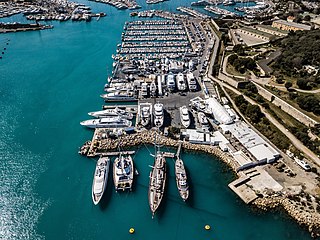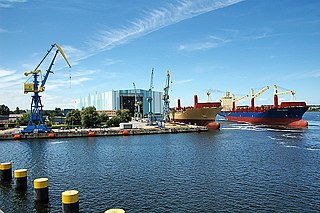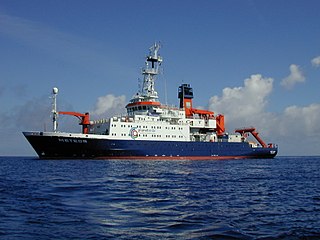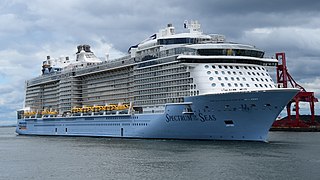
Blohm+Voss (B+V), also written historically as Blohm & Voss, Blohm und Voß etc., is a German shipbuilding and engineering company. Founded in Hamburg in 1877 to specialise in steel-hulled ships, its most famous product was the World War II battleship Bismarck. In the 1930s, its owners established the Hamburger Flugzeugbau aircraft manufacturer which, shortly before the outbreak of World War II, adopted the name of its parent company. Following a difficult period after the war, B+V was revived, changing ownership among several owners, as Thyssen Group and Star Capital. In 2016, it became a subsidiary of Lürssen and continues to supply both the military and civilian markets. It serves two areas – new construction of warships as NVL B.V. & Co. KG, and new construction and refitting of megayachts. The company has been in operation, building ships and other large machinery, almost continuously for 147 years.

A shipyard, also called a dockyard or boatyard, is a place where ships are built and repaired. These can be yachts, military vessels, cruise liners or other cargo or passenger ships. Compared to shipyards, which are sometimes more involved with original construction, dockyards are sometimes more linked with maintenance and basing activities. The terms are routinely used interchangeably, in part because the evolution of dockyards and shipyards has often caused them to change or merge roles.

MS Estonia was a cruiseferry built in 1980 for the Finnish shipping company Rederi Ab Sally by Meyer Werft, in Papenburg, West Germany. She was employed on ferry routes between Finland and Sweden by various companies until 1993, when she was sold to Nordström & Thulin for use on Estline's Tallinn–Stockholm route. The ship's sinking on 28 September 1994, in the Baltic Sea between Sweden, Finland and Estonia, was one of the worst peacetime maritime disasters of the 20th century, claiming 852 lives.

Meyer Werft is a German shipyard headquartered in Papenburg at the river Ems. Founded in 1795 and starting with small wooden vessels, today Meyer Werft is a builder of luxury passenger ships. 700 ships of different types have been built at the yard. Its "Dockhalle 2" is the third largest shipbuilding hall and the building with the fifth-largest usable volume in the world as of 2022.

Deutsche Schiff- und Maschinenbau Aktiengesellschaft was a cooperation of eight German shipyards in the period 1926 to 1945. The leading company was the shipyard AG Weser in Bremen.

STX Finland Oy, formerly Aker Yards Oy, was a Finnish shipbuilding company operating three shipyards in Finland, in Turku, Helsinki and Rauma, employing some 2,500 people. It was part of STX Europe, a group of international shipbuilding companies owned by the South Korean STX Corporation.

Pella Sietas was a shipbuilding company in Neuenfelde, Cranz, in southwest Hamburg. It was created from the insolvent firm of J.J Sietas KG Schiffswerft GmbH u. Co. It is located in the estuary of the Este river at Unterelbe. On 29 July 2021 the company filed for insolvency. The insolvency proceedings against the assets of the responsible shipyard are open.

The A-Rosa Aqua is a German river cruise ship, cruising in the Rhine – Main – Moselle basin. The ship was built by Neptun Werft GmbH at their shipyard in Warnemünde, Germany, and entered service in July 2009. Her sister ships are A-Rosa Brava and A-Rosa Viva. Her home port is currently Rostock.

The A-Rosa Viva is a German river cruise ship, cruising in the Rhine – Main – Moselle basin. The ship was built by Neptun Werft GmbH at their shipyard in Warnemünde, Germany, and entered service in March 2010. Her sister ships are A-Rosa Aqua and A-Rosa Brava. Her home port is currently Rostock.

The A-Rosa Donna is a German river cruise ship, cruising on the Danube river. The ship was built by Neptun Werft GmbH at their shipyard in Warnemünde, Germany, and entered service in May 2002. Her sister ships are A-Rosa Bella, A-Rosa Mia and A-Rosa Riva. Her home port is currently Rostock.

The A-Rosa Riva is a German river cruise ship, cruising on the Danube river. The ship was built by Neptun Werft GmbH at their shipyard in Warnemünde, Germany, and entered service in April 2004. Her sister ships are A-Rosa Bella, A-Rosa Donna and A-Rosa Mia. Her home port is currently Rostock.

Meyer Wismar is a German shipbuilding company, headquartered in Wismar. After June 1, 1990 it was part of the Deutschen Maschinen- und Schiffbau AG, from 2009 it was part of the Nordic Yards Holding GmbH, and in 2016 it became part of the Lloyd Werft Group. In June 2022 Thyssenkrupp Marine Systems (TKMS) acquired the Wismar site of MV Werften. In November 2022, a lease agreement was signed with Meyer Werft to complete the Global Dream with the yard renamed Meyer Wismar.

The RV Meteor is a multidisciplinary research vessel operating mainly on the high sea. She is owned by the German state represented by its Federal Ministry of Education and Research and registered in Hamburg.

MS Iona is an Excellence-class cruise ship in service for P&O Cruises, a subsidiary of Carnival Corporation & plc. Built by German shipbuilder Meyer Werft in Papenburg, she was delivered in October 2020 at a cost of £730 million. At 184,089 GT, Iona became the largest cruise ship commissioned for P&O and the British market upon delivery until sister ship Arvia was delivered in 2022. Iona was floated out on 18 February 2020 and delivered eight months later on 9 October amid the COVID-19 pandemic, which delayed her debut by more than a year until 7 August 2021, when she sailed her maiden voyage from Southampton.

MV Werften was a Hong Kong–German shipbuilding company that operated three facilities in eastern Germany to construct cruise ships for parent company Genting Hong Kong.

The Global class is a class of cruise ships constructed by the German shipbuilder MV Werften for Genting Hong Kong. With Genting’s bankruptcy in 2022, the future of the Global class was in doubt. On November 16, 2022, Disney Cruise Line confirmed it acquired the unfinished Global Dream. The second unfinished ship has been scrapped.

Spectrum of the Seas is a Quantum-Ultra-class cruise ship currently operated by Royal Caribbean International and the first ship of the Quantum Ultra class, a modification from the company's Quantum class of ships. The ship was constructed at Meyer Werft in Papenburg, Germany and was delivered in April 2019. At 169,379 GT, she became the fifth largest ship in the fleet by gross tonnage upon delivery. She currently operates primarily in East Asia.

Spirit of Adventure is a cruise ship operated by Saga Cruises and constructed by Meyer Werft in Papenburg, Germany. As Saga's second new-build vessel, she was originally considered as an option in the cruise line's pursuit to renew its fleet, but the company finalised the order in 2017 after seeing rising profits in its travel business following the announcement of her sister ship, Spirit of Discovery. Her keel was laid on 3 June 2019 and she was delivered on 29 September 2020, but in response to travel restrictions caused by the COVID-19 pandemic, the inaugural cruise was continuously postponed until she officially debuted on 26 July 2021.

Silver Nova is a luxury cruise ship, the 12th ship in service with Silversea Cruises. She was ordered in 2018 and completed in 2023. Nova is the first ship in the company's new Evolution-class, and designed with the intent of environmentally friendly cruising. It is the first hybrid luxury cruise ship, powered by a combination of liquefied natural gas (LNG), fuel cell system, and batteries, enabling it to be emissions free when in port. The ship was built at a Meyer Werft in Germany, featuring a unique asymmetrical design.





















